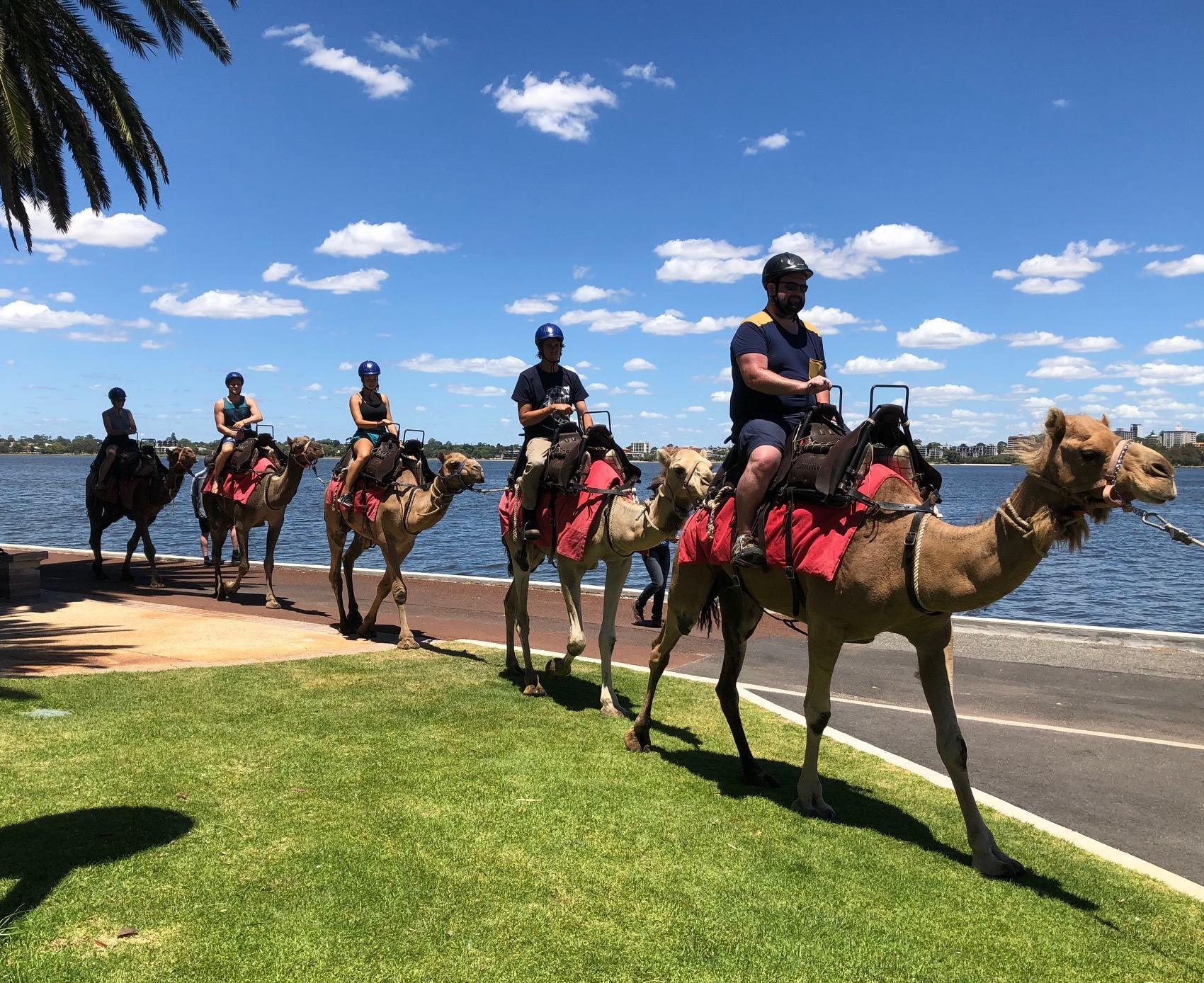Camel tours are the new way to see Perth
In time for direct flights from the UK, there's a new way to see Perth. David Whitley joins 'Gemma' for a look around the city

The fisherman on the riverbank looks borderline terrified as he turns round to see a small train of camels approaching. I get similar reactions from the cyclists coming down the cycle path, and from the ambling tourists on the way to the Rottnest Island ferry jetty.
Around the world, there are certain destinations where you expect to see camels. Dubai’s deserts, perhaps. Or around the pyramids in Egypt. There are even places in Australia well known for camel rides – they’re a staple at Cable Beach in Broome, and are one of the gimmicks found around Uluru in an attempt to keep visitors there for a few days.
But Perth city centre? Not so much. Yet the unflappable Jon Warren has decided that the heart of a city with a population of 1.67 million is exactly the place to run camel-led tours. He started the project in January 2018. And he says it’s the fault of the miners.
“My partner manages an apartment hotel, and we went to a conference where there was a lot of fear about Perth’s hotel boom, and the lower demand from the resources industry,” he explains. Increased supply and lower demand means room prices have come crashing down over the last few years – great news for visitors, but less so for hotel owners.
“It was decided that we need to encourage more things to do,” says Jon. “I originally worked on sheep stations, and I thought: ‘I know where there are some camels…’”
His dromedary recruits include Gemma, my steed: a former racing camel who absolutely insists in going at the front of the group every time. She seems otherwise unflustered – which, given the ungainly process of getting on board, can only be a good thing.
Jon and his cohorts at Camel West have arranged a metal platform with steps, which makes it considerably easier to reach camel hump height. But getting in the saddle still involves an almighty swing of the leg, while narrowly avoiding kicking the camel behind in the face.
Once everyone’s mounted, the camels are chivvied into touch, and we begin a lumbering plod along the north bank of the Swan river. The motion is unlike that of a horse – it’s less jarring and bumpy, and considerably more lurchy. It’s more rolling backwards and forwards in the saddle than juddering up and down.
Jon walks alongside as Gemma and her followers plod gamely along, and he tells the story of how Australia ended up with so many camels.
The first to arrive was Harry, who came from the Canary Islands in 1840. He was used for inland exploration by John Ainsworth Horrocks. Harry, alas, ended up shooting his owner by unexpectedly moving while Horrocks was reloading his gun.
Other imports were more successful. Camels proved to be the perfect beasts of burden for putting infrastructure across Australia’s unforgiving outback. They became integral to the building of telegraph and train lines, and between 15,000 and 20,000 camels were imported, mainly from India.
They were so effective that they eventually made themselves obsolete – the trains they made room for could do the heavy lifting. But by this stage, the herders had become rather attached to their camels. When the state governments ordered a cull, they released their camels into the wild instead.
The animals didn’t just survive; they thrived, to the point where Australia has the largest wild population in the world. There are hundreds of thousands of them, and culling has been required to keep numbers down.
Well, culling and capturing. Jon got most of his camels from the barren, almost treeless Nullarbor Plain in southern Australia. “Then I had to figure out how to deal with them,” he says. “I found some good camel men, and learned how to break them in.”
The absurd rides through central Perth have launched after months of training – both in terms of getting camels used to traffic and people, and employees used to the camels. And eventually, they’re likely to become a part of the scenery.
For now, though, the weird factor is pretty high. Towards the end of the tour, the camel train turns into Barrack Square, the most touristy spot in the entire city. It lollops past the showy, glassy bell tower, parades past the tour operator shacks and souvenir huts, and provokes double takes from people slurping ice creams. The ships of the desert, it seems, do alright near inner-city ferry terminals too.
Travel essentials
Getting there
Qantas flies direct from Heathrow to Perth from £1095. Indirect flights start at around £800.
Staying there
The Attika hotel in Northbridge, the cultural and nightlife district just north of the city centre, offers slickly-decorated apartments with kitchens and laundry facilities from $189 (£135).
More information
Tours with Camel West leave six times a day, take 30 minutes and cost $45.
Subscribe to Independent Premium to bookmark this article
Want to bookmark your favourite articles and stories to read or reference later? Start your Independent Premium subscription today.

Join our commenting forum
Join thought-provoking conversations, follow other Independent readers and see their replies